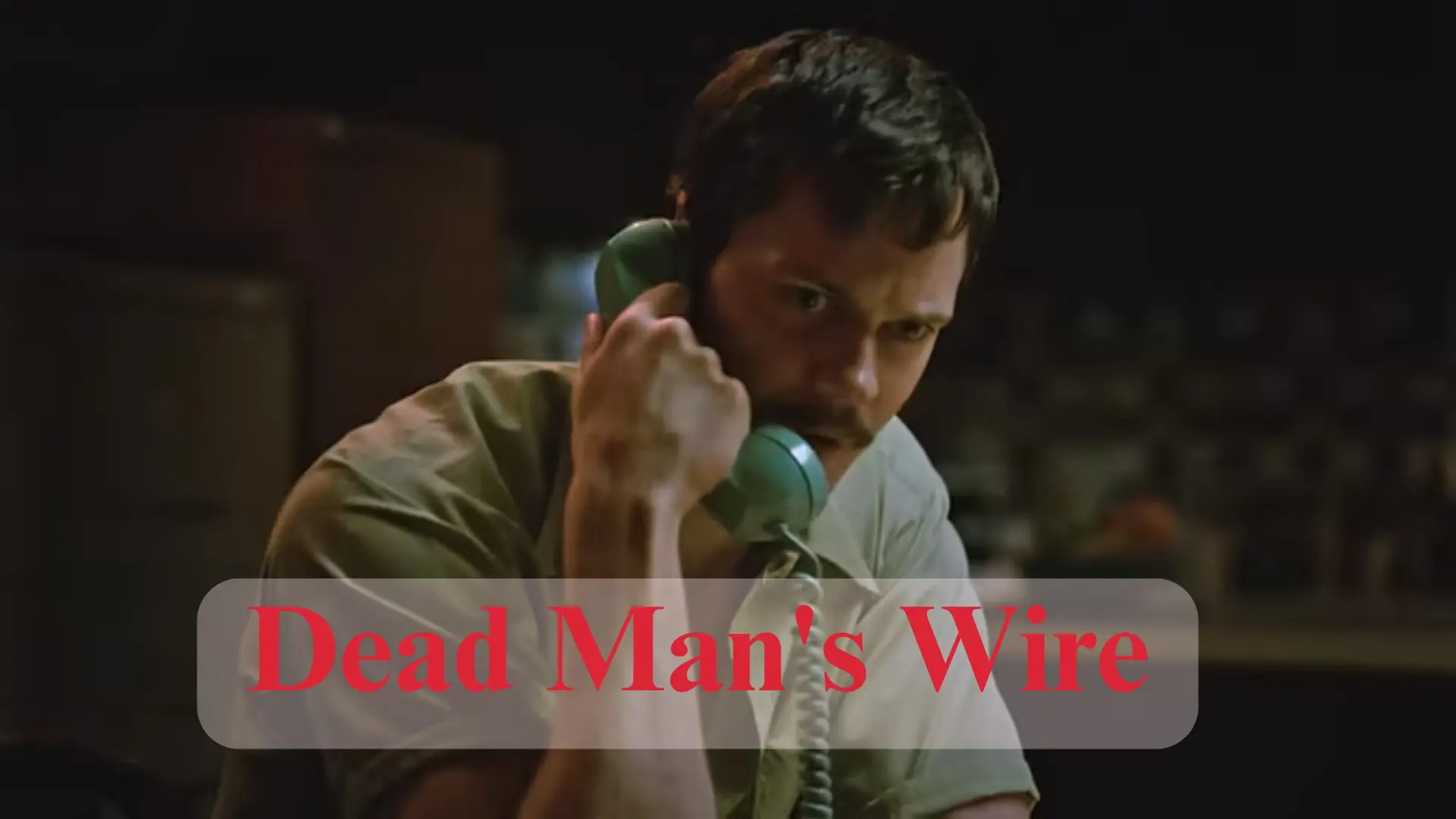Movie blog — Dead Man’s Wire (2025): Hostage Drama, Media Spectacle, and the Anatomy of a Fringe Hero.
Gus Van Sant returns to cinema with Dead Man’s Wire, a moody, darkly comic retelling of one of America’s strangest hostage standoffs. Based on a real 1977 incident, the film turns Tony Kiritsis — the Indianapolis man who famously wired a sawed-off shotgun to his own neck and held a mortgage executive hostage on live television — into a combustible cinematic figure: part desperado, part would-be folk hero, part media-created caricature. Van Sant’s approach is measured and empathetic, balancing satire and sorrow while letting Bill Skarsgård inhabit a role that could’ve easily tilted into cartoonish excess.
Quick facts you’ll want to know
Title: Dead Man’s Wire (2025).
Director: Gus Van Sant. Writer: Austin Kolodney. Music: Danny Elfman.
Premiere: World premiere out of competition at the Venice Film Festival — September 2, 2025 — later playing TIFF and Chicago fest.
Runtime: ~105 minutes. Distributor: Row K Entertainment (North America). Limited theatrical release scheduled January 2026.
Cast — how many, and who’s who.
Dead Man’s Wire is built around a tight core ensemble. The credited principal cast includes:
- Bill Skarsgård as Tony Kiritsis (the man who stages the seizure).
- Dacre Montgomery as Richard (Dick) Hall, the hostage / mortgage executive.
- Colman Domingo as Fred Temple (a key local figure).
- Myha’la (Harvey) as Linda Page.
- Cary Elwes as Detective Michael Grable.
- John Robinson, Kelly Lynch, Todd Gable, Mark Helms, Al Pacino in a supporting role as M.L. Hall (the hostage’s father), and a handful of other credited actors.
Counting principals and significant supporting roles, you’re looking at roughly 12–18 named performers with clear narrative weight — a focused ensemble that allows the film to alternate between claustrophobic hostage scenes and the wider social fallout.
Who is the “means character” — who carries the story?
While the film sometimes stretches into ensemble territory (media figures, cops, family members get quiet beats), this is unequivocally Tony Kiritsis’s picture. Bill Skarsgård’s portrayal anchors the film: we enter the standoff through his weathered logic, sardonic humor, and the dizzying blend of self-righteousness and genuine rage that drives his actions. Van Sant treats Tony not merely as a villain or simple villain-in-waiting but as a man shaped by humiliation and a system he believes crushed him. That complexity makes Kiritsis the clear “means character” — the viewpoint that gives the movie its moral and emotional gravity.
The premise & why it still matters.
The true story (briefly): on February 8, 1977, Tony Kiritsis entered the office of his mortgage company, took its president (Dick Hall) hostage, rigged the gun so it would kill both men if Kiritsis was shot or incapacitated, demanded money and an apology — and the confrontation became a televised, days-long spectacle that fascinated the nation. Kiritsis’s mix of performative bravado and heartfelt grievance tapped raw nerves about power, money and how institutions treat ordinary people. Van Sant’s film revisits that strange intersection of vigilante impulse and live-media spectacle, asking what it means when the marginalized weaponize attention itself.
Box office & release plan — measured, festival-first.
Because Dead Man’s Wire premiered at Venice and TIFF before Row K Entertainment bought North American rights, it’s following the classic arthouse festival→limited→expand theatrical path. Row K set limited US release dates for January 2026 (starting Jan 9 limited, expanding Jan 16). That distribution strategy signals a prestige-first play (awards, reviews, critical conversation) rather than an immediate wide tentpole push.
At the time of writing the film’s theatrical grosses are not significant (it’s just starting commercial rollout), and financial tracking pages list the title but do not yet show wide box-office returns. Early indicators — festival praise and strong trade reviews — suggest the film is poised to perform respectably for an adult, issue-driven drama in specialty release, though it’s not aimed at blockbuster numbers. (Industry outlets note the Venice/TIFF festival circuit and Row K acquisition as signs the film will be positioned for awards season and adult audiences.)
Niche & tone — what kind of movie is this?
Dead Man’s Wire sits at the intersection of true-crime drama, psychological character study, and media satire. It’s the kind of film that interests viewers who like their crime movies to probe social causes rather than just record violence. Van Sant pulls from his indie-drama toolkit — patient long takes, an ear for quiet absurdities, and sympathy for marginalized figures — while letting tense, procedural beats steer the plot. The tone moves between grim (the morally fraught hostage setup), darkly comic (Kiritsis’s bluster and the surreal media circus), and elegiac (the human cost beneath the spectacle). If you enjoyed Van Sant’s more observational work or character-driven true-crime films that ask “why?” rather than “whodunit?”, this sits in your wheelhouse.

Plot—deep dive (spoilers kept to a minimum).
Van Sant opens the movie in medias res: we meet a man slumping into an act that will become national news. The film focuses tightly on Kiritsis’s decision to make his protest irreversible — the dead-man’s wire — and then alternates three registers:
- The hostage room — long, claustrophobic stretches where Kiritsis and Hall negotiate, argue, and expose histories. Van Sant stages these scenes to let tension simmer; the gun’s mechanical inevitability makes every exchange feel like a moral wager. Bill Skarsgård is magnetic here: his Kiritsis is both angry and unbearably lonely.
- The outside world — family members, cops, and a media machine that immediately frames the event. Van Sant skewers TV’s rush to turn crisis into ratings without losing sight of actual human consequence. The film captures how a private grievance becomes public theater — and how that spectacle reshapes the participants’ identities.
- The backstory — flashbacks and context that reveal Kiritsis’s sense of grievance: foreclosure, humiliation, the feeling of being cheated by financial actors. Van Sant refuses to exonerate him, but he does unpack the battered logic that led to the standoff. The film asks us to bathe our judgment in complexity: anger can be criminal and understandable at once.
The pacing is deliberate; Van Sant avoids sensationalist montage. Instead the Dead Man’s Wire film lets the hostage stand-off unspool in real time, with recurring moments of dark humor undercutting the menace. The ending leans into ambiguity — the legal and ethical consequences are explored but the film refuses a neat closing moralizing speech.
Performances & craft — what lifts the film.
Bill Skarsgård gives one of his strongest, most controlled screen performances: equal parts fury, charm and melancholy. Reviewers have noted this as his most committed work to date.
Dacre Montgomery is credible as the hostage, playing Dick Hall less like a cipher and more like an emblem of institutional power who’s also scared and human.
Colman Domingo and Al Pacino (in a smaller but memorable role) add gravitas and counterpoint, giving the film a texture of moral and legal complexity.
Gus Van Sant’s direction is a major asset: his taste for observational empathy, his willingness to find black humor in dire situations, and his capacity to stage scenes that feel both immediate and archetypal make the film feel alive rather than exploitative. Arnaud Potier’s cinematography and Danny Elfman’s score (unexpected but effective) help the movie feel of the period while staying cinematic
What works — and what might divide audiences.
Strengths
- The film humanizes a headline while refusing to romanticize violence; that balancing act is rare and often instructive.
- Skarsgård’s lead turn is magnetic and complex, giving viewers a character whose motives should provoke thought rather than a simple verdict.
- Van Sant’s blend of satire and sympathy lets the film operate both as a character study and a critique of spectacle culture.
Potential weaknesses
- The subject matter could be divisive: transforming a real, traumatic criminal episode into art risks reopening wounds for survivors or inviting critiques of exploitation. Van Sant treads carefully, but the ethical tightrope is thin.
- The film’s deliberate tempo and its refusal to pronounce a single moral judgment may frustrate audiences who want clear answers or a more forceful condemnation.
Final verdict of Dead Man’s Wire Movie.
Dead Man’s Wire is a smart, strange piece of cinema — Van Sant at his curious best: compassionate without being soft, sardonic without being mean. It’s a portrait of a man pushed to a theatrical extreme, and it’s a mirror to a culture that turns trauma into programming and suspects into stars. This isn’t light entertainment. It’s a film that wants you to watch, to feel uncomfortable, and then to think about why we cheer or jeer the people who make themselves unignorable.
If you’re interested in contemporary takes on true crime that avoid simplistic verdicts, or if you follow Van Sant’s work and enjoy performances that dig beneath headlines, Dead Man’s Wire is a must-see. Expect to walk out unsettled, slightly wiser, and wondering how quickly the next scandal will appear on your glowing screen.





